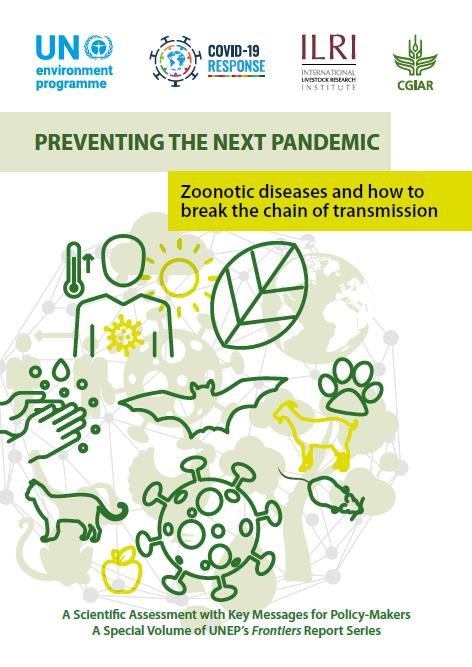- Share this article
- Subscribe to our newsletter
Preventing the Next Pandemic
Further outbreaks will emerge unless governments take active measures to prevent other zoonotic diseases from crossing into the human population, the report Preventing the Next Pandemic: Zoonotic diseases and how to break the chain of transmission warns. It was published by the United Nations Environment Programme (UNEP) and the International Livestock Research Institute (ILRI) in July 2020.
The report identifies seven trends driving the increasing emergence of zoonotic diseases, including increased demand for animal protein; a rise in intense and unsustainable farming; the increased use and exploitation of wildlife; and the climate crisis. It finds that Africa in particular, which has experienced and responded to a number of zoonotic epidemics including most recently, to Ebola outbreaks, could be a source of important solutions to quell future outbreaks.
A “zoonotic disease” or “zoonosis” is a disease that has passed into the human population from an animal source. COVID-19, which has already caused more than half a million deaths around the world, most likely originated in bats. But COVID-19 is only the latest in a growing number of diseases – including Ebola, MERS, West Nile fever and Rift Valley fever – whose spread from animal hosts into human populations has been intensified by anthropogenic pressures.
Every year, some two million people, mostly in low- and middle-income countries, die from neglected zoonotic diseases. The same outbreaks can cause severe illness, deaths, and productivity losses among livestock populations in the developing world, a major problem that keeps hundreds of millions of small-scale farmers in severe poverty. In the last two decades alone, zoonotic diseases have caused economic losses of more than USD 100 billion, not including the cost of the COVID-19 pandemic, which is expected to reach USD 9 trillion over the next few years.
The report’s authors identify the One Health approach - which unites public health, veterinary and environmental expertise - as the optimal method for preventing as well as responding to zoonotic disease outbreaks and pandemics. They identify ten practical steps that governments can take to prevent future zoonotic outbreaks:
- Investing in interdisciplinary approaches, including One Health;
- Expanding scientific enquiry into zoonotic diseases;
- Improving cost-benefit analyses of interventions to include full-cost accounting of societal impacts of disease;
- Raising awareness of zoonotic diseases;
- Strengthening monitoring and regulation practices associated with zoonotic diseases, including food systems;
- Incentivizing sustainable land management practices and developing alternatives for food security and livelihoods that do not rely on the destruction of habitats and of biodiversity;
- Improving biosecurity and control, identifying key drivers of emerging diseases in animal husbandry and encouraging proven management and zoonotic disease control measures;
- Supporting the sustainable management of landscapes and seascapes that enhance sustainable co-existence of agriculture and wildlife;
- Strengthening capacities among health stakeholders in all countries; and
- Operationalizing the One Health approach in land-use and sustainable development planning, implementation and monitoring, among other fields.
Author: (UNEP/ile)
Read more and download the report Preventing the Next Pandemic: Zoonotic diseases and how to break the chain of transmissionat UNEP website:





Add a comment
Be the First to Comment